
It intends to increase the cooperation across international boundaries to foster and support CH professionals in their work with the development of advanced conservation methods.
This includes:
• debates on practices that concern the conservation of CH collections;
• joint work with higher learning institutions;
• identify deteriorated movable and/or immovable tangible heritage requiring conservation approaches that differ significantly to those used ordinarily.
Key activities are:
• to create an European repository which collects all open-access information and results obtained within EU-funded projects;
• to provide a database of materials, analytical tools and practices;
• to support the creation of an information system for laboratories;
• to provide a background for establishing and standardizing good practices in CH conservation.
It intends to guarantee a continuing high-level training courses system on the use of new materials and products in the conservation field (e.g. workshops on the application of methodologies and the use of nanosystems).